ignition Hyundai Elantra Touring 2012 Owner's Manual
[x] Cancel search | Manufacturer: HYUNDAI, Model Year: 2012, Model line: Elantra Touring, Model: Hyundai Elantra Touring 2012Pages: 402, PDF Size: 5.49 MB
Page 16 of 402

INSTRUMENT PANEL OVERVIEW
1. Driver’s front air bag........................3-45
2. Light control / Turn signals ..............4-54
3. Instrument cluster ...........................4-37
4. Wiper / Washer switch ....................4-59
5. Auto cruise controls* .......................5-26
6. Ignition switch ...................................5-5
7. Steering wheel ................................4-27
8. Digital clock* .......................................4-92
9. Audio controls* .....................4-99, 4-104
10. Climate control system* ................4-66
11. Hazard warning flasher switch ......4-53
12. Seat warmer* ..................................3-7
13. Shift lever ........................................5-7
14. Cigarette lighter.............................4-89
15. Power outlet ..................................4-91
16. Ashtray ..........................................4-89
17. Passenger’s front air bag ..............3-45
18. Multi box* ......................................4-87
19. Vent controls .................................4-69
20. Glove box ......................................4-85
* : if equipped
OFD029002N
B020000AFD
23
Your vehicle at a glance
Page 24 of 402

37
Safety features of your vehicle
Removal
To remove the headrest, raise it as far as
it can go then press the release button (1)
while pulling upward (2).
To reinstall the headrest, put the headrest
poles(3) into the holes while pressing the
release button(1). Then adjust it to the
appropriate height.C010105AFD
Lumbar support (for driver’s seat, if equipped)
The lumbar support can be adjusted by
moving the lever on the outside of the dri-
ver’s seatback. Pivoting the lever increas-
es or decreases lumbar support.
C010107AFD
Seat warmer (if equipped)
The seat warmer is provided to warm the
front seats during cold weather. With the
ignition switch in the ON position, push
either of the switches to warm the driver's
seat or the front passenger's seat.
During mild weather or under conditions
where the operation of the seat warmer
is not needed, keep the switches in the
"OFF" position.
Each time you push the button, the temperature setting of the seat is
changed as follows :
OFD039038
WARNING
Make sure the headrest locks in
position after adjusting it to proper-
ly protect the occupants.
OFD037005OFD037006
OFF → HIGH ( ) → LOW ( )
→
Page 25 of 402

Safety features of your vehicle
83
The seat warmer defaults to the OFFposition whenever the ignition switch is
turned on.
✽ ✽ NOTICE
With the seat warmer switch in ON
position, the heating system in the seat
turns off or on automatically depending
on the seat temperature.
C010108AUN-EU
Seatback pocket (if equipped)
The seatback pocket is provided on the
back of the front passenger’s and driver’s
seatbacks.
CAUTION
When cleaning the seats, do not
use an organic solvent such asthinner, benzene, alcohol or gaso-line. Doing so may damage thesurface of the heater or seats.
To prevent overheating the seat warmer, do not place anything onthe seats that insulates againstheat, such as blankets, cushionsor seat covers while the seatwarmer is in operation.
Do not place heavy or sharp objects on seats equipped withseat warmers. Damage to the seatwarming components could occur.
WARNING- Seat warmer burns
Passengers should use extreme
caution when using seat warmers
due to the possibility of excess heat-
ing or burns. The seat warmer may
cause burns even at low tempera-
tures, especially if used for long peri-
ods of time. In particular, the driver
must exercise extreme care for the
following types of passengers:
1. Infants, children, elderly or hand-
icapped persons, or hospital out-
patients
2. Persons with sensitive skin or those that burn easily
3. Fatigued individuals
4. Intoxicated individuals
5. Individuals taking medication that can cause drowsiness or
sleepiness (sleeping pills, cold
tablets, etc.)
WARNING- Seatback
pockets
Do not put heavy or sharp objects
in the seatback pockets. In an acci-
dent they could come loose from
the pocket and injure vehicle occu-
pants.
OFD037040
Page 31 of 402
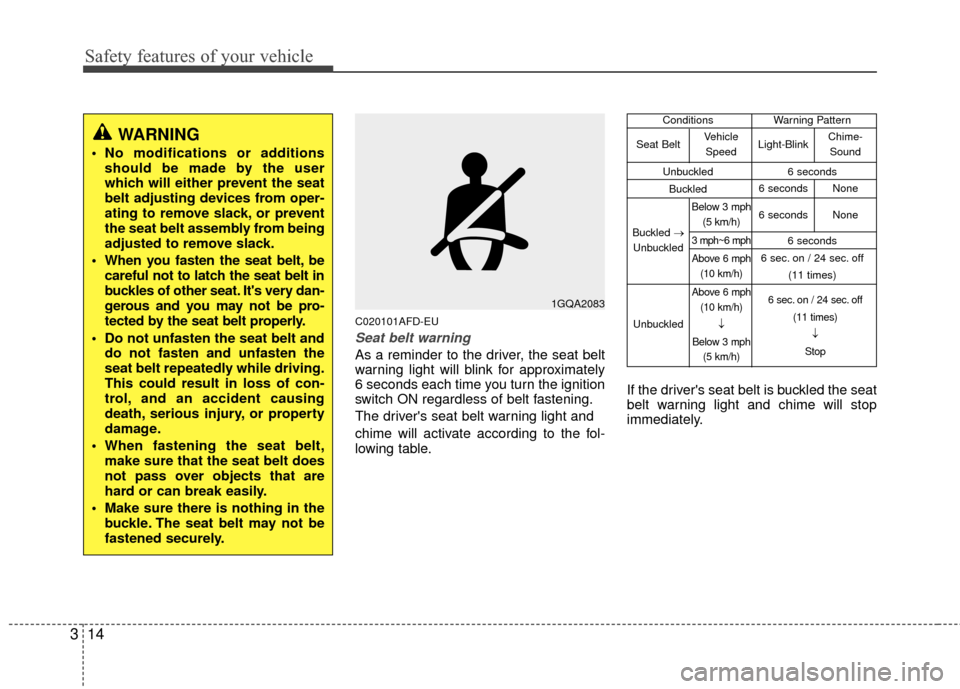
Safety features of your vehicle
14
3
C020101AFD-EU
Seat belt warning
As a reminder to the driver, the seat belt
warning light will blink for approximately
6 seconds each time you turn the ignition
switch ON regardless of belt fastening.
The driver's seat belt warning light and
chime will activate according to the fol-
lowing table. If the driver's seat belt is buckled the seat
belt warning light and chime will stop
immediately.
1GQA2083Conditions Warning Pattern
Unbuckled 6 seconds Buckled
6 seconds
6 sec. on / 24 sec. off (11 times)
Seat Belt
Buckled →
Unbuckled
Unbuckled Vehicle
Speed
Below 3 mph (5 km/h)
3 mph~6 mph
Above 6 mph(10 km/h)
Above 6 mph (10 km/h)
↓
Below 3 mph (5 km/h) 6 sec. on / 24 sec. off
(11 times)↓
Stop
Light-Blink
6 seconds None
6 seconds None Chime-
SoundWARNING
No modifications or additions should be made by the user
which will either prevent the seat
belt adjusting devices from oper-
ating to remove slack, or prevent
the seat belt assembly from being
adjusted to remove slack.
When you fasten the seat belt, be careful not to latch the seat belt in
buckles of other seat. It's very dan-
gerous and you may not be pro-
tected by the seat belt properly.
Do not unfasten the seat belt and do not fasten and unfasten the
seat belt repeatedly while driving.
This could result in loss of con-
trol, and an accident causing
death, serious injury, or property
damage.
When fastening the seat belt, make sure that the seat belt does
not pass over objects that are
hard or can break easily.
Make sure there is nothing in the buckle. The seat belt may not be
fastened securely.
Page 39 of 402
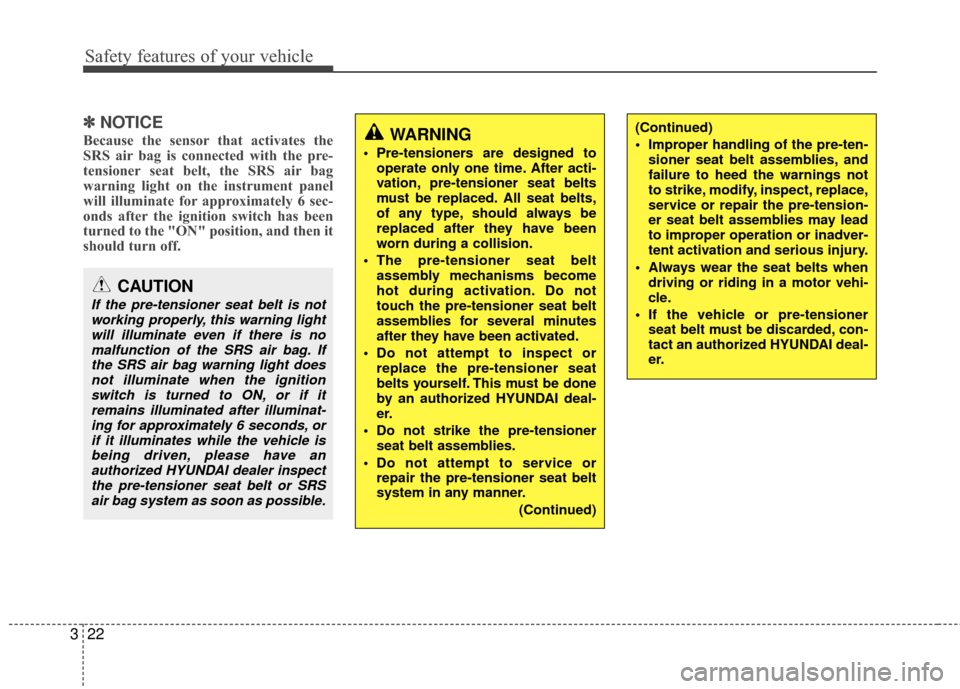
Safety features of your vehicle
22
3
✽
✽
NOTICE
Because the sensor that activates the
SRS air bag is connected with the pre-
tensioner seat belt, the SRS air bag
warning light on the instrument panel
will illuminate for approximately 6 sec-
onds after the ignition switch has been
turned to the "ON" position, and then it
should turn off.(Continued)
Improper handling of the pre-ten-
sioner seat belt assemblies, and
failure to heed the warnings not
to strike, modify, inspect, replace,
service or repair the pre-tension-
er seat belt assemblies may lead
to improper operation or inadver-
tent activation and serious injury.
Always wear the seat belts when driving or riding in a motor vehi-
cle.
If the vehicle or pre-tensioner seat belt must be discarded, con-
tact an authorized HYUNDAI deal-
er.WARNING
Pre-tensioners are designed to
operate only one time. After acti-
vation, pre-tensioner seat belts
must be replaced. All seat belts,
of any type, should always be
replaced after they have been
worn during a collision.
The pre-tensioner seat belt assembly mechanisms become
hot during activation. Do not
touch the pre-tensioner seat belt
assemblies for several minutes
after they have been activated.
Do not attempt to inspect or replace the pre-tensioner seat
belts yourself. This must be done
by an authorized HYUNDAI deal-
er.
Do not strike the pre-tensioner seat belt assemblies.
Do not attempt to service or repair the pre-tensioner seat belt
system in any manner.
(Continued)
CAUTION
If the pre-tensioner seat belt is notworking properly, this warning lightwill illuminate even if there is nomalfunction of the SRS air bag. Ifthe SRS air bag warning light doesnot illuminate when the ignition switch is turned to ON, or if itremains illuminated after illuminat-ing for approximately 6 seconds, orif it illuminates while the vehicle isbeing driven, please have anauthorized HYUNDAI dealer inspectthe pre-tensioner seat belt or SRSair bag system as soon as possible.
Page 52 of 402
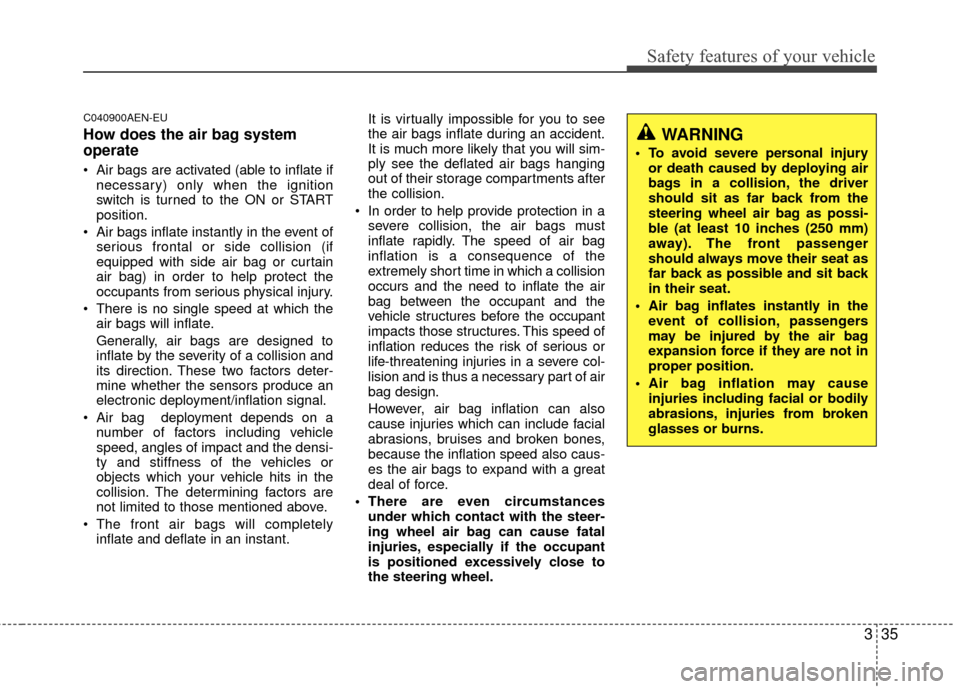
335
Safety features of your vehicle
C040900AEN-EU
How does the air bag system
operate
Air bags are activated (able to inflate ifnecessary) only when the ignition
switch is turned to the ON or START
position.
Air bags inflate instantly in the event of serious frontal or side collision (if
equipped with side air bag or curtain
air bag) in order to help protect the
occupants from serious physical injury.
There is no single speed at which the air bags will inflate.
Generally, air bags are designed to
inflate by the severity of a collision and
its direction. These two factors deter-
mine whether the sensors produce an
electronic deployment/inflation signal.
Air bag deployment depends on a number of factors including vehicle
speed, angles of impact and the densi-
ty and stiffness of the vehicles or
objects which your vehicle hits in the
collision. The determining factors are
not limited to those mentioned above.
The front air bags will completely inflate and deflate in an instant. It is virtually impossible for you to see
the air bags inflate during an accident.
It is much more likely that you will sim-
ply see the deflated air bags hanging
out of their storage compartments after
the collision.
In order to help provide protection in a severe collision, the air bags must
inflate rapidly. The speed of air bag
inflation is a consequence of the
extremely short time in which a collision
occurs and the need to inflate the air
bag between the occupant and the
vehicle structures before the occupant
impacts those structures. This speed of
inflation reduces the risk of serious or
life-threatening injuries in a severe col-
lision and is thus a necessary part of air
bag design.
However, air bag inflation can also
cause injuries which can include facial
abrasions, bruises and broken bones,
because the inflation speed also caus-
es the air bags to expand with a great
deal of force.
There are even circumstances under which contact with the steer-
ing wheel air bag can cause fatal
injuries, especially if the occupant
is positioned excessively close to
the steering wheel.
WARNING
To avoid severe personal injuryor death caused by deploying air
bags in a collision, the driver
should sit as far back from the
steering wheel air bag as possi-
ble (at least 10 inches (250 mm)
away). The front passenger
should always move their seat as
far back as possible and sit back
in their seat.
Air bag inflates instantly in the event of collision, passengers
may be injured by the air bag
expansion force if they are not in
proper position.
Air bag inflation may cause injuries including facial or bodily
abrasions, injuries from broken
glasses or burns.
Page 54 of 402
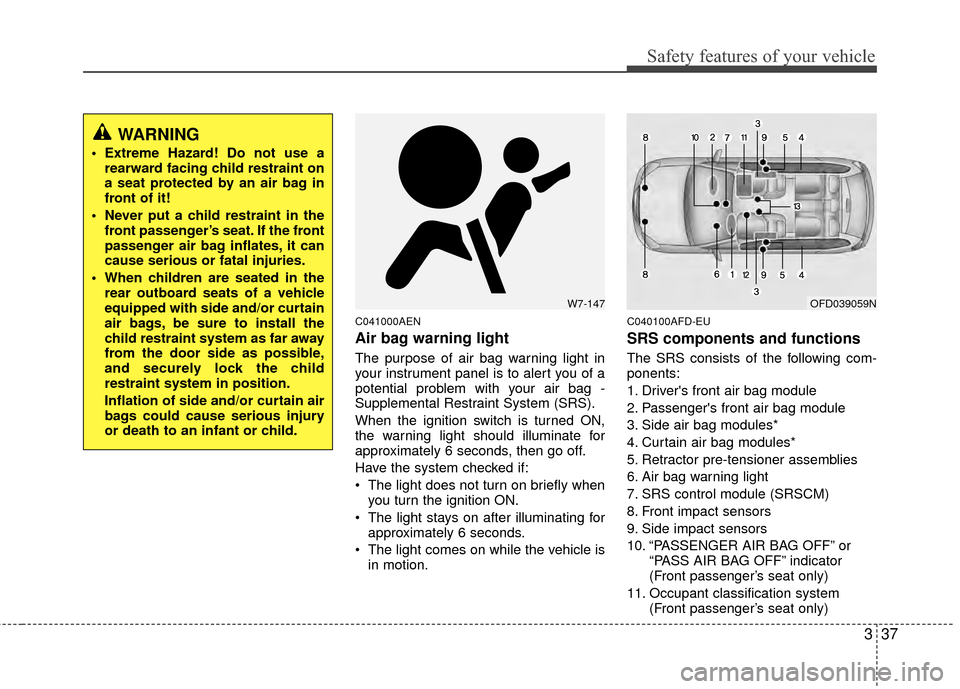
337
Safety features of your vehicle
C041000AEN
Air bag warning light
The purpose of air bag warning light in
your instrument panel is to alert you of a
potential problem with your air bag -
Supplemental Restraint System (SRS).
When the ignition switch is turned ON,
the warning light should illuminate for
approximately 6 seconds, then go off.
Have the system checked if:
The light does not turn on briefly whenyou turn the ignition ON.
The light stays on after illuminating for approximately 6 seconds.
The light comes on while the vehicle is in motion.
C040100AFD-EU
SRS components and functions
The SRS consists of the following com-
ponents:
1. Driver's front air bag module
2. Passenger's front air bag module
3. Side air bag modules*
4. Curtain air bag modules*
5. Retractor pre-tensioner assemblies
6. Air bag warning light
7. SRS control module (SRSCM)
8. Front impact sensors
9. Side impact sensors
10. “PASSENGER AIR BAG OFF” or “PASS AIR BAG OFF” indicator
(Front passenger’s seat only)
11. Occupant classification system (Front passenger’s seat only)
WARNING
Extreme Hazard! Do not use arearward facing child restraint on
a seat protected by an air bag in
front of it!
Never put a child restraint in the front passenger’s seat. If the front
passenger air bag inflates, it can
cause serious or fatal injuries.
When children are seated in the rear outboard seats of a vehicle
equipped with side and/or curtain
air bags, be sure to install the
child restraint system as far away
from the door side as possible,
and securely lock the child
restraint system in position.
Inflation of side and/or curtain air
bags could cause serious injury
or death to an infant or child.
W7-147OFD039059N
Page 55 of 402
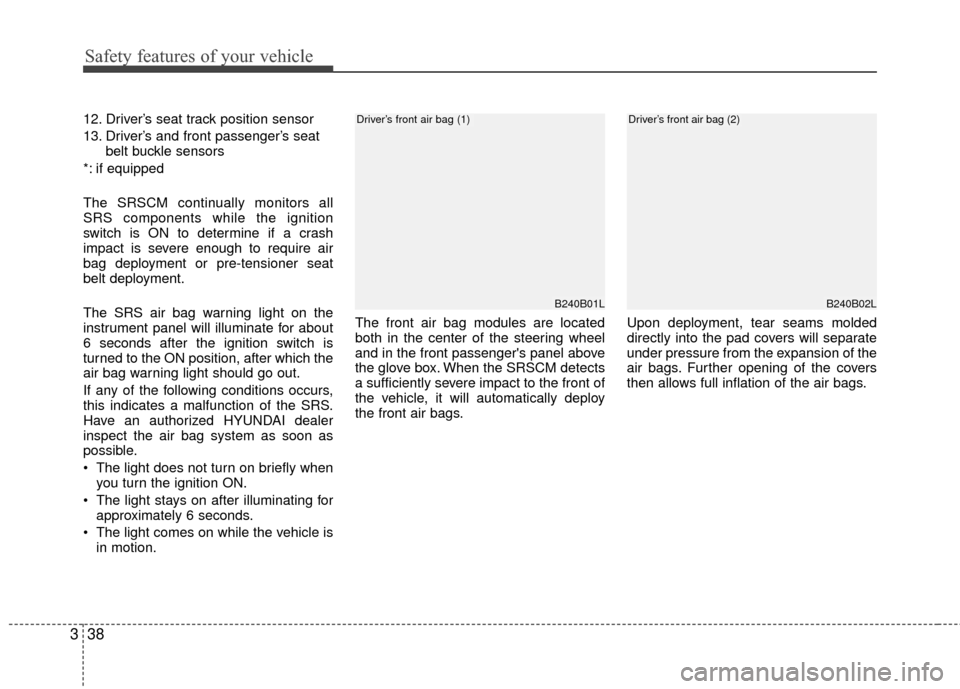
Safety features of your vehicle
38
3
12. Driver’s seat track position sensor
13. Driver’s and front passenger’s seat
belt buckle sensors
*: if equipped
The SRSCM continually monitors all
SRS components while the ignition
switch is ON to determine if a crash
impact is severe enough to require air
bag deployment or pre-tensioner seat
belt deployment.
The SRS air bag warning light on the
instrument panel will illuminate for about
6 seconds after the ignition switch is
turned to the ON position, after which the
air bag warning light should go out.
If any of the following conditions occurs,
this indicates a malfunction of the SRS.
Have an authorized HYUNDAI dealer
inspect the air bag system as soon as
possible.
The light does not turn on briefly when you turn the ignition ON.
The light stays on after illuminating for approximately 6 seconds.
The light comes on while the vehicle is in motion. The front air bag modules are located
both in the center of the steering wheel
and in the front passenger's panel above
the glove box. When the SRSCM detects
a sufficiently severe impact to the front of
the vehicle, it will automatically deploy
the front air bags.
Upon deployment, tear seams molded
directly into the pad covers will separate
under pressure from the expansion of the
air bags. Further opening of the covers
then allows full inflation of the air bags.
B240B01L
Driver’s front air bag (1)
B240B02L
Driver’s front air bag (2)
Page 57 of 402
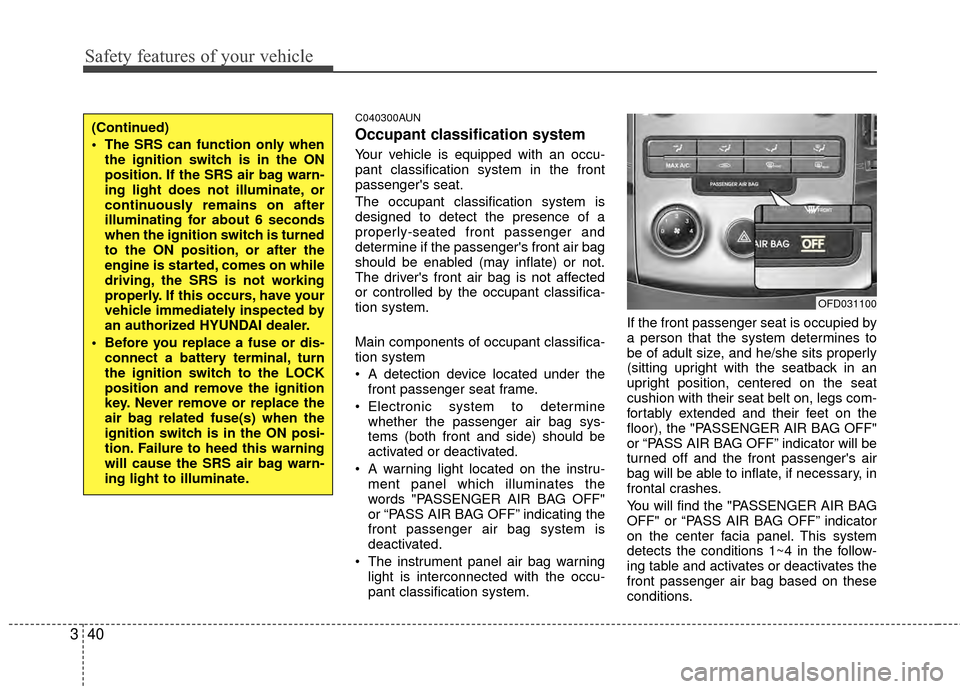
Safety features of your vehicle
40
3
C040300AUN
Occupant classification system
Your vehicle is equipped with an occu-
pant classification system in the front
passenger's seat.
The occupant classification system is
designed to detect the presence of a
properly-seated front passenger and
determine if the passenger's front air bag
should be enabled (may inflate) or not.
The driver's front air bag is not affected
or controlled by the occupant classifica-
tion system.
Main components of occupant classifica-
tion system
A detection device located under the
front passenger seat frame.
Electronic system to determine whether the passenger air bag sys-
tems (both front and side) should be
activated or deactivated.
A warning light located on the instru- ment panel which illuminates the
words "PASSENGER AIR BAG OFF"
or “PASS AIR BAG OFF” indicating the
front passenger air bag system is
deactivated.
The instrument panel air bag warning light is interconnected with the occu-
pant classification system. If the front passenger seat is occupied by
a person that the system determines to
be of adult size, and he/she sits properly
(sitting upright with the seatback in an
upright position, centered on the seat
cushion with their seat belt on, legs com-
fortably extended and their feet on the
floor), the "PASSENGER AIR BAG OFF"
or “PASS AIR BAG OFF” indicator will be
turned off and the front passenger's air
bag will be able to inflate, if necessary, in
frontal crashes.
You will find the "PASSENGER AIR BAG
OFF" or “PASS AIR BAG OFF” indicator
on the center facia panel. This system
detects the conditions 1~4 in the follow-
ing table and activates or deactivates the
front passenger air bag based on these
conditions.
(Continued)
The SRS can function only when
the ignition switch is in the ON
position. If the SRS air bag warn-
ing light does not illuminate, or
continuously remains on after
illuminating for about 6 seconds
when the ignition switch is turned
to the ON position, or after the
engine is started, comes on while
driving, the SRS is not working
properly. If this occurs, have your
vehicle immediately inspected by
an authorized HYUNDAI dealer.
Before you replace a fuse or dis- connect a battery terminal, turn
the ignition switch to the LOCK
position and remove the ignition
key. Never remove or replace the
air bag related fuse(s) when the
ignition switch is in the ON posi-
tion. Failure to heed this warning
will cause the SRS air bag warn-
ing light to illuminate.
OFD031100
Page 60 of 402
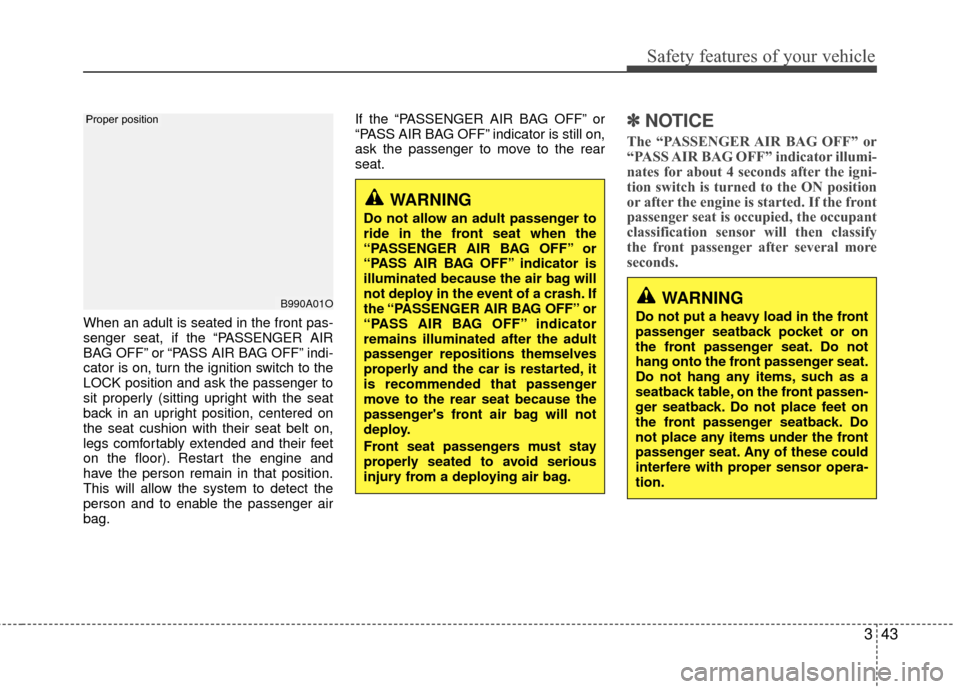
343
Safety features of your vehicle
When an adult is seated in the front pas-
senger seat, if the “PASSENGER AIR
BAG OFF” or “PASS AIR BAG OFF” indi-
cator is on, turn the ignition switch to the
LOCK position and ask the passenger to
sit properly (sitting upright with the seat
back in an upright position, centered on
the seat cushion with their seat belt on,
legs comfortably extended and their feet
on the floor). Restart the engine and
have the person remain in that position.
This will allow the system to detect the
person and to enable the passenger air
bag.If the “PASSENGER AIR BAG OFF” or
“PASS AIR BAG OFF” indicator is still on,
ask the passenger to move to the rear
seat.
✽ ✽
NOTICE
The “PASSENGER AIR BAG OFF” or
“PASS AIR BAG OFF” indicator illumi-
nates for about 4 seconds after the igni-
tion switch is turned to the ON position
or after the engine is started. If the front
passenger seat is occupied, the occupant
classification sensor will then classify
the front passenger after several more
seconds.
B990A01O
WARNING
Do not allow an adult passenger to
ride in the front seat when the
“PASSENGER AIR BAG OFF” or
“PASS AIR BAG OFF” indicator is
illuminated because the air bag will
not deploy in the event of a crash. If
the “PASSENGER AIR BAG OFF” or
“PASS AIR BAG OFF” indicator
remains illuminated after the adult
passenger repositions themselves
properly and the car is restarted, it
is recommended that passenger
move to the rear seat because the
passenger's front air bag will not
deploy.
Front seat passengers must stay
properly seated to avoid serious
injury from a deploying air bag.
WARNING
Do not put a heavy load in the front
passenger seatback pocket or on
the front passenger seat. Do not
hang onto the front passenger seat.
Do not hang any items, such as a
seatback table, on the front passen-
ger seatback. Do not place feet on
the front passenger seatback. Do
not place any items under the front
passenger seat. Any of these could
interfere with proper sensor opera-
tion.
Proper position